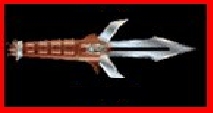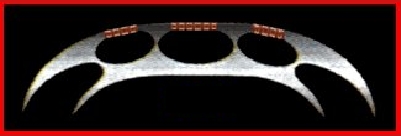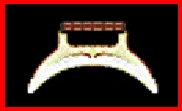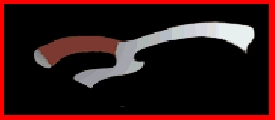 |
|
|
|
|
|
|
|
|
|
|
|
|
|
|
|
|
|
|
|
|
|
|
|
|
|
|
|
|
|
|
|
|
|
|
|
Klin Zha Kinta Weapons |
|
|
A grand master of Klin Zha must take many factors into account when choosing a move in Klin Zha Kinta. A grand master must have knowledge of the various skills of his players and the fighting style and type of weapon carried by all of his players. A Klin Zha Kinta player had many weapons to choose from before a game. In most Klin Zha Kinta matches the controlling officer would choose the different weapons for each player on his team. In many ways the choice of weapon determined his choice in tactics. All players except the Lancer have a choice of several different weapons. Klin Zha Kinta rules call for the Lancer to always be armed with a Lance. All players are armed with a backup weapon called the Daqtag (small dagger). This weapon is usually only used if the primary weapon is broken.
|
|
|
 |
|
|
The Mace is the default weapon used in Klin Zha Kinta it is the weapon carried by all players if other weapons are not chosen. Several Thought Admirals advocated that only the mace should be allowed in the Year Games. However, The Year Games Chancellor ruled that choice in weapons improved that tactical study of Kln Zha Kinta. Some players will prefer to play without choice in weapons because choice can slow game play. In this case all players would be armed with the Mace.
The weapons bellow are the weapons that may be chosen before a game. Players may not swap weapons during a game nor may players capture enemy weapons. (However, some border worlds allowed players to capture a defeated player's weapon) Weapons are individually chosen and designated on the Klin Zha Kinta scorecard. An opponent may not know which weapon a player is armed with until he has challenged the player in combat. The choice of weapon for each player brings Klin Zha Kinta to its highest level of tactical thought. Players should be aware that games will take a bit more time and more recording is necessary than in the regular game. However, Klin Zha Kinta games have infinite tactical possibilities for the player who desires a serious tactical challenge.
|
|
|
 |
|
|
|
Daqtagh |
|
|
| The Daqtagh is a small Klingon dagger carried by all Klin Zha Kinta players. The Daqtagh is a secondary weapon only. It is only used if the primary weapon is lost or disabled. The Daqtagh may not be used during the same attack as another weapon is being used. A Daqtagh hits using the same attack value of a player, however a Dagtagh can only do 1 point of damage per attack. |
|
|
 |
|
|
|
ChonnaQ |
|
|
| The ChonnaQ is a long weapon similar to a pike that is specifically designed to penetrate a Blockader's heavy armor. The ChonnaQ is large and difficult to wield. A Fencer, Vanguard, Blockader, Swift or Flier may carry a ChonnaQ. The ChonnaQ is ideal for killing a Bloackader. A player using a ChonnaQ against a Blockader will hit normally using their attack value. However, when a hit is scored the ChonnaQ will always do 6 damage points to a Blockader. The ChonnaQ has several disadvantages against other players. A ChonnaQ may not be used against a Swift or a Flier. Both players are able to evade the clumsy ChonnaQ. The ChonnaQ may be used against all other players by adding 2 to the spindle roll when determining a hit. This +2 will make it difficult to score a hit but when a hit is scored will do significant damage. |
|
|
 |
|
|
|
Bat'leth |
|
|
| A Bat'leth is an elegant weapon that can make rapid cutting attacks. The Bat'leth can be used by the Fencer, Vanguard or Swift. If a player uses a Bat'leth he or she makes two attacks attempts in a row. Hits are determined by a roll of spindle based on the players attack value as before, however, a Bat'leth hit always scores 2 damage to an opponent. Therefore per attack round a Bat'leth can do a maximum of 4 damage points. |
|
|
 |
|
|
|
Jejtaj |
|
|
| The Jejtaj is a one handed purely defensive weapon. It can block any type of weapon attack. The other free hand may carry a Daqtagh for attacks or counter-attacks. The Jejtaj blocks a blow from any weapon with the roll of a 1, 2, 3 of the spindles. After a blow is parried or attack hits a Daqtagh counter attack may take place. This is the only weapon that can be used at the same time as the Daqtagh. |
|
|
 |
|
|
|
Mek'leth |
|
|
| The Mek'leth is a good versatile weapon commonly carried by Vanguards. A Mek'leth is good for attacking and for blocking attacks. A Mek'leth attack is determined by the normal attack values. However, all hits always do 2 points of damage. The Mek'leth can sometimes parry blows from a Bat'leth or a Oy'naQ. When a player with a Bat'leth or a Oy'naQ attacks a player with a Mek'leth, the Mek'leth player has a chance to block or even break the attacking weapon. When a attack is scored on a Mek'leth player he rolls the spindles. If the roll is a 1 the Bat'leth or Oy'na is broken and can not be used for the rest of the game. If the roll is a 2 the blow is blocked successfully. A roll of 3-6 means the blow was not stopped and damage results normally. |
|
|
 |
|
|
|
Oy'naQ |
|
|
| The Oy'naQ is a tactically interesting weapon. It is a long pain stick capable of rendering a player temporally paralyzed. An Oy'naQ is the only weapon with long range. It can be used only by player from an adjacent triangle. An Oy'naQ attack may only be attempted once. A hit is determined by using the normal attack values. If a hit is scored an enemy player is unable to move for three turns. (ie. Turn 1 green lancer paralyzed, Turn 2, green moves but may not move Lancer, Turn 3 gold moves, may attack the green Lancer. Turn 4 green Lancer may move again.) When a player attacks a paralyzed enemy player the attacking player is able to make two attacks without being counter-attacked. After the third attack a paralyzed player will wake up and be able to counterattack normally. A disadvantage of the Oy'naQ is that is may not be used at short range. Therefore a player with a Oy'naQ will have to use a Daqtagh when attacking or counter-attacking. A Oy'naQ may be used against a Blockader, however because the Oy'naQ must be used in the zone of control of the Blockader the player must successfully hit the bloackader to stay in the space adjacent to the enemy Blockader. If the attack with the Oy'naQ misses the Blockader, the attacking player must back up one space in the direction it came from. This movement backwards is conducted even the player has no movement points remaining. A paralyzed Blockader will not be able to impose a zone of control during the turn it is temporarily paralyzed. |
|
| Mines |
|
|
Mines were outlawed for use in the Year Games. Many Thought Admirals spoke out against the use of a weapon that killed so dishonorably. However, mines were used on several border worlds, most notably on the Klingon / Romulan border. Although mines were rarely used, the rules for mines are included for those players wishing to recreate the bloody games played on the frontiers. The rules for mines varied in different parts of the Empire. On the Romulan border captured Romulans (kuve) were forced to play Klin Zha Kinta. The controlling officer would choose 1 player that would carry a mine instead of a weapon. The player could drop the mine in any space he passed through or landed on. The mine would only go off when later in the game, a player ended his movement in that space. If a friendly or enemy player ended their move in a space with a mine the player would be killed by the mine. If the player was holding a goal, the goal would stay unharmed in abandoned in the space. On the prison world of Rura Penthe, Klin Zha Kinta was played by many different races. On this barbaric world a controlling player could arm any number of his players with mines instead of weapons if he so desired. In one well-known game an ingenious Starfleet prisoner won his freedom by winning against the prison warden. He opted for an entirely defensive strategy by arming all nine of his players with mines instead of weapons. A player with a mine will still carry a Daqtagh. When laying a mine in a space record the coordinates to prove its location to your opponent. Note that passing through a space with a mine will not set it off.
|
|
| Chan Sutai Kolarch (Chandler Archibald) |
|
|
Back to Klin Zha Kinta Rules |
|
|
|






